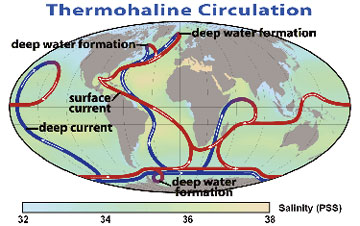101308OldWater.jpg

Thermohaline circulation. This collection of currents is responsible for the large-scale exchange of water masses in the ocean, including providing oxygen to the deep ocean. The entire circulation pattern takes ~2000 years. Credit: NASA
Like wine, ocean water has its own vintage — in essence, the date it was bottled. Marine scientists determine the vintage by measuring the water’s chemistry. The oldest water mass in the oceans may be almost a thousand years old.
It may be surprising to hear that not all ocean water is alike. The oceans consist of great masses of water. Each mass is determined by its temperature and salinity. It begins to age after it loses contact with the surface.
Scientists determine the age of a water mass by measuring its chemistry.
They track the amount of oxygen it contains, for example. Water at the surface absorbs oxygen from the atmosphere. But when it sinks away from the surface, living organisms consume the oxygen. So the longer a water mass stays in the ocean depths, the less oxygen it contains.
Another way to find the age is to measure the amount of carbon-14, which is absorbed from the atmosphere in the form of carbon dioxide. It decays with a half-life of about 5700 years. In other words, if the carbon-14 isn’t replenished from the air, half of it would disappear in 5700 years. So by measuring the carbon-14, scientists can determine how long a water mass has been away from the surface.
The oldest water mass is found in the North Pacific. Water flows in from both the South Pacific and the North Atlantic. This cold, dense water pools at the bottom. And most measurements suggest that it’s been circulating for up to a thousand years.

